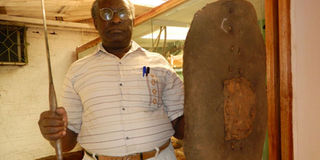I spent my millions on artifacts

Director of the Kipsigis Museum Paul Tum demonstrates how the shield and spear was used by the warriors of the Kipsigis Community when they fought in the battle of Moogoori over 150 years ago. Photo/Timothy Kimei
What you need to know:
- Mr Tum lectures Mathematics at Moi University’s Kericho Campus. His museum is located at Kapkatet in Bureti district.
- The museum has collections from as far back as 18th century. They include war weapons and tools for tillage, harvesting and serving foods.
- Visitors aged above 80 years are given free entry.
History has it that a battle at the present-day Nyamira County the lives of several Kipsigis men around 1900.
Historian Wanguhu Ng’ang’a writes that Kipsigis men, who were then dominant in war, assembled at Bureti and went to raid the Abagusii despite a warning by the community’s Laibon.
It came to be known as the Battle of Mogori.
“The Bureti males were almost wiped out. However, a few people managed to escape from this massacre,” eccentric Kalenjin politician and linguist Taaita Toweet, whose uncle died in the battle, is quoted saying in Ng’ang’a’s book, Kenya’s Ethnic Communities: Foundation of the Nation.
Ng’ang’a writes that the Battle of Mogori is etched in the memory of the community. “The Kipsigis say that there had never occurred another massacre like the Mogori one,” he notes.
Much about the battle and how it led to marriages of convenience between Kisii men and Kipsigis women has faded with time.
However, an artifact at a museum in Kericho County is sure to bring back the memories — a shield believed to have been brought from the Battle of Mogori.
The shield is one of more than 1,000 artifacts collected over six years by a mathematics lecturer who runs the museum, Mr Paul Tum.
Mr Tum has a collection of historical items at his Kipkurben Museum of Art and Science that have cost him close to Sh2 million.
They include traditional musical instruments like the one-stringed kimengeng, the five-stringed chepkesem, the six stringed chemonget and eight-stringed ketuba.
Mr Tum lectures Mathematics at Moi University’s Kericho Campus. His museum is located at Kapkatet in Bureti district.
He is now pursuing a PhD degree and many would expect him to leave the field of language and culture to history and literary scholars such Taban Lo Liyong and Chris Wanjala.
But his passion would not let him. He has devoted Sh20,000 each month for the cause.
In 2008, Mr Tum resorted to collecting anything about the culture of his people to salvage a few remaining artifacts that he knew were at the risk of disappearing.
RESPONSE WAS GREAT
“I made it known publicly that I would buy any artifact at least Sh500 a piece. The response was great as I have since collected over 1,000 different traditional artifacts,” he told the Nation at the museum.
He not only received items from the Kalenjin but also from the Maasai, Kamba and Luos.
The latest items at the museum include a kipsilwet, a bowl-like item used by mothers to clean their hands and breasts before feeding their babies.
“I’m willing to share all this with willing partners,” he said.
The museum has collections from as far back as 18th century. They include war weapons and tools for tillage, harvesting and serving foods.
It is frequently visited by school children who are brought in to learn about different cultures.
The site is open throughout the week from 9am to 5pm on weekdays or to 6.30pm on weekends.
Kenyan children pay Sh10 and adults Sh20. Foreign visitors pay between Sh100 and Sh200.
Visitors aged above 80 years are given free entry.
The centre has a library with books written in Kipsigis language.
Among the books in the shelves are The Legend Explored by Kipkoech arap Sambu (2011), The Social Institution of the Kipsigis by Dr Ivan Perestiany (1939) and The Kipsigis by Henry Ochardsar (1961).
“Nothing is as soul-soothing as a firm educational foundation linking the past and the present with our future dreams,” he said. “It cannot come in any better way than preserving our cultures.”
Tell us the interesting things about your town. Send your stories to [email protected]





